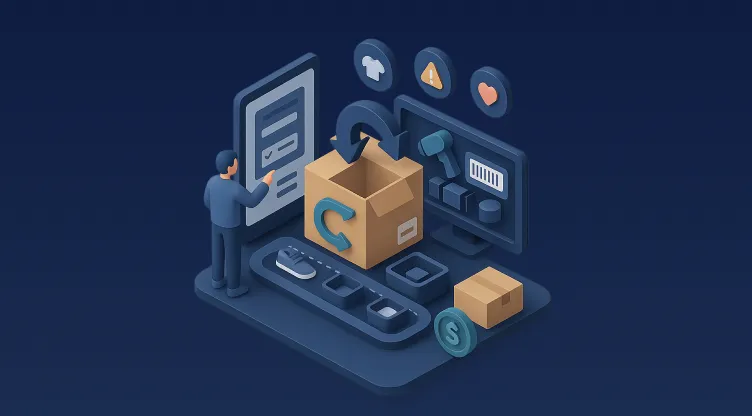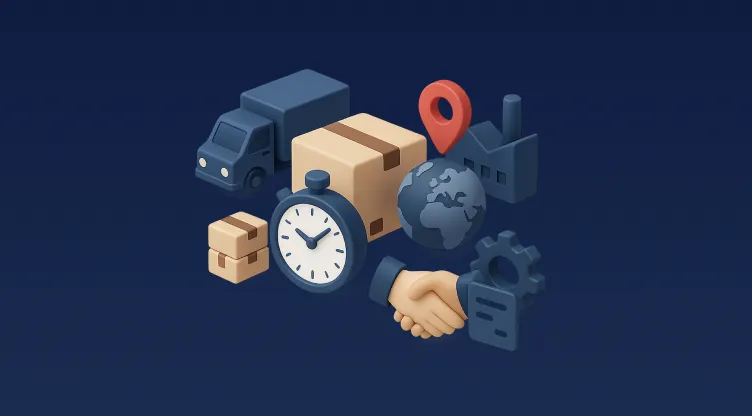Quick Takeaways: Ecommerce Returns Management
- Ecommerce returns (reverse logistics) significantly affect customer loyalty, brand image, and profit margins.
- 92% of shoppers are more likely to buy again if the returns process is easy.
- Key reasons for returns include sizing issues, inaccurate descriptions, or product damage.
- Returns can reach up to 40% in fashion ecommerce—much higher than other industries.
- Automating returns, improving warehouse handling, and using data analytics help optimise the process.
- Omnichannel return options and AI-driven sizing tools reduce return rates and improve customer experience.
- Fraudulent returns and unsustainable practices can hurt margins—clear policies and eco-friendly options are key.
- Omniful offers integrated, real-time returns management that enhances efficiency and profitability.
Ecommerce reverse logistics is a big part of running an online store. It impacts your customers’ satisfaction, your profits, and the overall image of your brand. When returns are handled smoothly, it can help keep customers coming back, make your operations more efficient, and save you some money. In this guide from Omniful, we’ll go over some straightforward ways to manage ecommerce returns, including tips on warehouse reports, ecommerce reverse logistics reverse logistics, online returns processing, and how to adjust your returns policy optimisation.
What is Ecommerce Returns Management?
Ecommerce returns management is all about how retailers handle products that customers send back. This process, often called reverse logistics, covers everything from picking up the returned items to checking their condition, putting them back on the shelves, fixing them up, or getting rid of them. Good returns management makes sure this whole process runs smoothly, keeping costs down and getting the most value out of the returns.
Why is an Effective Returns Process Essential?
A well-planned returns process is essential to keeping customers loyal. Research shows that 92% of customers make repeat purchases from retailers who offer simple return procedures. Efficient processes reduce costs related to ecommerce reverse logistics through savings in labour as well as storage and transportation expenses. This approach aids businesses in expanding their profit margins and refining their returns management systems.
Common Reasons Customers Return Products
Customers frequently return products because descriptions & images fail to accurately match the actual items, often showing colour discrepancies.
- The product description or pictures weren't right (like the fitting was off).
- The size wasn't right, mostly with clothes.
- The item was broken because of bad packaging.
- The person just didn't want it, or it wasn't what they thought it would be.
- It was too hard to put together, like furniture or electronics.
Businesses can decrease return rates by addressing the underlying causes of product returns through trigger analysis.
Challenges in Ecommerce Returns Management
The effects of high return rates on company profits are substantial and detrimental.
E-commerce returns average 20-30% across industries, but fashion experience rates are as high as 40%. Returns generate expenses related to shipping along with inspection & restocking, which diminish profit margins. Small businesses may find their operations severely disrupted when they lack strong online returns processing solutions.
Managing Reverse Logistics Efficiently
The movement of goods from customers to warehouses through reverse logistics presents a complicated process. Inadequate warehouse reports and processing delays create risks of inventory discrepancies, leading to excess stock or missed sales opportunities.
Fraudulent Returns and Chargebacks
Retailers lose a lot of money every year due to fraudulent return activities such as "wardrobing" & "fake damage" claims. In ecommerce reverse logistics - organisations must implement verification protocols to effectively reduce losses.
Customer Expectations for Hassle-Free Returns
Modern customers expect retailers to offer return policies that are both inexpensive and straightforward. The possibility exists that customers will shop at other stores if your return rules appear too strict. Loose return rules expose your business to potential scams. Success in online returns processing requires you to find an equilibrium between consumer demands and your business capabilities.
Environmental Concerns and Sustainability in Returns
The increasing understanding of carbon footprints has led consumers and regulators to advocate for sustainable practices. Systems for handling online returns & recycling programs can cut down on waste while promoting sustainability.
How to Optimise Your Ecommerce Returns Process
Step 1: Make Your Return Policy Clear and Easy to Understand
A simple return policy helps customers know what to expect and reduces confusion. Important points to include are:
- Eligibility Criteria: Specify which products can be returned by customers along with the conditions necessary for return eligibility.
- Timeframes: State the exact timeframe within which customers may send products back for return.
- Procedures: The return procedure requires customers to follow exact instructions to begin their return process.
- Refund Methods: Outline all refund and exchange processes along with their respective timelines & methods.
Transparency in your return policy can enhance customer trust and reduce disputes.
Step 2: Implement an Automated Returns Management System
The automation technology used for returns processing results in substantial efficiency improvements. Benefits include:
- Reduced Manual Errors: Automated systems help eliminate human errors during data input & processing tasks.
- Faster Processing: Automated systems accelerate the processing of return authorisations and refund transactions.
- Enhanced Tracking: The system provides real-time return status updates to customers and staff members.
The adoption of these systems will lead to more efficient operations while enhancing customer satisfaction.
Step 3: Use Data Analytics to Track Return Trends
Analysing return data will reveal customer reasons for sending your inventory back. You can solve the return issue & decrease the number of future returns through this method. For example, adjust product descriptions and sizing charts when customers frequently return products because of sizing problems.
Step 4: Improve Warehouse Efficiency for Returns Processing
Proper warehouse management of returned items remains essential. Ecommerce reverse logistics strategies include:
- Dedicated Returns Area: Set up an exclusive area for processing returns to keep warehouse operations running smoothly and consistently.
- Standardised Procedures: Create standard operating procedures for return policy optimisations that assess returned items to identify candidates for restocking or disposal.
- Staff Training: Warehouse staff should receive training on returns processing to achieve efficiency, accuracy and better warehouse reports.
Step 5: Offer Multiple Return Options for Customer Convenience
Having various return options makes it easier for customers and keeps them happy. Some people like to return items in-store, while others prefer mailing them back or using third-party drop-off spots. By offering these choices, you can build customer loyalty and make returns less of a hassle.
Different online return methods cater to what customers want, improving their overall shopping experience.
Ecommerce Returns Best Practices
Managing ecommerce reverse logistics well can make things easier for your business & keep customers happy. Here are some simple returns policy optimisation strategies:
Make Returns Easy Across All Channels
Let customers return items bought online at your physical stores and vice versa. This makes the returns process smoother and improves the overall customer experience.
Offer Real-Time Tracking for Returns
Give customers the ability to track their return shipments in real time. Being clear about where their returns are builds trust and cuts down on questions about return statuses.
Automate Refund and Exchange Processing
Set up automated systems to handle refunds and exchanges as soon as returned items are inspected. This speeds things up, reduces mistakes, and keeps customers happy.
Partner with Third-Party Logistics (3PL) Providers for Returns
Collaborate with third-party logistics partners to manage returns more smoothly. The partners focus on returns management through collection, inspection, refurbishment & restocking services that lowers your business's operational load.
Leverage Sustainability Initiatives for Eco-Friendly Returns
Reduce environmental impact by adopting sustainable practices throughout your returns process. Strategies include:
- Encouraging Responsible Consumer Behaviour: Educate consumers about ecommerce reverse logistics/returns environmental effects to promote smarter shopping decisions.
- Starting Recycling Programs: You should recycle the inventory that cannot be sold anymore!
Being eco-friendly helps the planet & draws in shoppers who really care about our planet.
How to Reduce Returns in Ecommerce
Lowering returns matters just as much as making the return process smoother. Here are some strategies to prevent returns from happening in the first place:
Improve Product Descriptions and Images
Product descriptions that provide clear details alongside high-quality images enable customers to make informed decisions when they shop. The rate of product returns drops when customers have access to comprehensive product information. Product descriptions need to contain accurate details about sizes and materials along with specific features.
Enhance Customer Support and Pre-Sale Guidance
High-quality customer support throughout the pre-sale phase helps stop product returns. When customers have access to live chat support, along with size guides and answers to product-related questions, their confidence in making a purchase grows.
Use AI-Driven Sizing Recommendations for Fashion Ecommerce
AI sizing recommendations for online fashion stores can really cut down on sizing issues that often cause customers to return items. By using AI/ML, businesses can suggest the right sizes based on what customers have bought before and their body measurements, helping to keep return rates low.
Educate Customers About Product Usage and Care
Giving straightforward instructions on how to use and take care of products can lower the number of returns. When customers know how to use something, they’re less likely to be unhappy with it and send it back, whether it's clothes, gadgets, or furniture.
Identify and Address Repeat Returners
Businesses can save money by spotting customers who frequently return products & tackling their issues early on. When companies offer custom help or suggest better product choices, these customers can make smarter buying decisions and reduce their returns.
Final Thoughts
Managing ecommerce returns isn't just about saving money—it's about turning challenges into strengths. With customers expecting more and the complexities of handling returns growing, businesses need a reliable partner to make the returns process easier, boost warehouse efficiency, and provide useful reports. That's where Omniful.ai comes in. Our platform helps improve returns policies, reduce return rates with smart analytics, & automate returns processes to keep your operations efficient and sustainable. Reach out to us to book a quick demo!
FAQS
What are the best practices for ecommerce returns management?
Prioritise automation for online returns processing, craft a transparent returns policy optimisation strategy, and leverage warehouse reports to track efficiency. Offer omnichannel returns (e.g., in-store drop-offs), integrate AI-driven analytics to identify trends, and adopt eco-friendly practices like recycling programmes. These procedures refine ecommerce reverse logistics operations while simultaneously building customer trust and reducing operational costs.
How can businesses lower return rates in ecommerce?
Businesses can reduce ecommerce returns through hyper detailed product descriptions combined with AI-powered sizing tools for fashion items & pre-sale live chatbot assistance. To prevent buyer’s remorse, use high-resolution images together with 360° videos and customer education materials such as care guides. Utilise warehouse reports to flag repeat returners proactively so you can resolve the underlying problems and transform these individuals into loyal customers.
What is reverse logistics, and why is it important for returns?
Reverse logistics is all about getting goods from customers back to warehouses, which is really important for managing returns in ecommerce. When done well, it helps avoid delays in restocking, cuts down costs related to returns, and makes warehouse operations smoother. If you handle it right, returns can become a way to recover inventory, support sustainability, and keep customers coming back.
























